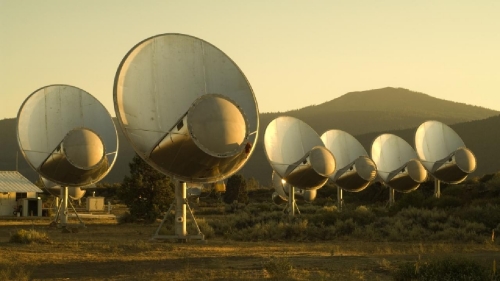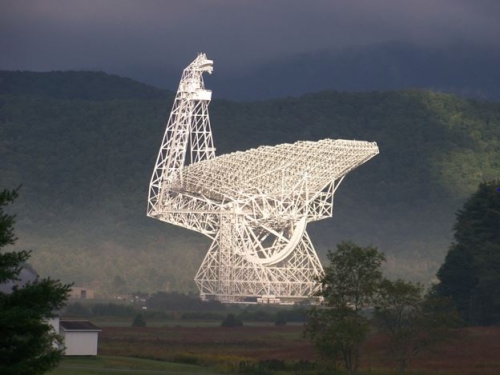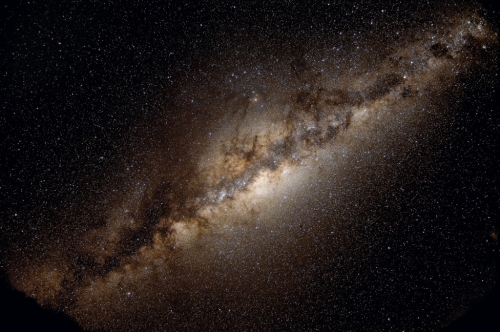Running a site like Centauri Dreams means adapting and reconfiguring on a daily basis. The best laid plans and all that… When I wrote recently about the SETI efforts at KIC 8462852, my plan had been to follow up that discussion with a broader SETI issue — where is the best place in the sky to search for a SETI signal? Then life intervened, first with my preparations to go to the Tennessee Valley Interstellar Workshop in Chattanooga, and then with the illness that cancelled those plans and left me with a thoroughly disrupted train of thought.
I’m now ready to tackle that SETI question with particular reference to a new paper by René Heller and Ralph E. Pudritz, but I still want to put the discussion into context. With the KIC 8462852 SETI effort, we looked at a targeted observation campaign using the Allen Telescope Array to see if researchers could find any evidence of unusual activity associated with the star. As we saw in Jim and Dominic Benford’s recent work (see Power Beaming Parameters & SETI re KIC 8462852), no evidence of microwave beaming could be found in the brief observational window, although our equipment would be capable of detecting many forms of it.
The unusual light curves in our Kepler data made KIC 8462852 a high-profile target. What the ATA search was looking for was ‘leakage’ radiation, associated with the activities of a technological civilization but not intended as deliberate attempts to communicate with anyone else. And the fact that we found nothing shouldn’t be taken too far in any particular direction. A thorough study of KIC 8462852 in a more systematic manner and at other frequencies would be called for if we wanted to investigate the star in depth and had the resources to do it long-term.
But what about this matter of leakage’ radiation? It’s an intriguing fact that there have been receptions of signals of a one-off nature (the Wow! signal is one) that could conceivably be the result of a beam sweeping past us from a distant system. Or, at least, consistent with it — these are pulsed, intermittent signals that were reported, for example, in a 1997 survey of the Milky Way’s center (citation below). We also have sources like GCRT J1745-3009, a transient bursting radio source that fails our expectations for flare stars, binary pulsars and much else.

Image: The Allen Telescope Array, recently used for a SETI effort at KIC 8462852. Credit: ATA.
A Communicating Civilization
SETI got started in the experimental way with Frank Drake’s work at Green Bank in 1960, targeting the close stars Tau Ceti and Epsilon Eridani. Here the intention was to listen out for a directed signal, a ‘hello’ announcement from another star system, and for one brief, unforgettable moment, Drake thought he had found one (the signal, we now know, was local). Given the nature of such directed beaming, this would theoretically be a much easier signal to detect, as it would stay fixed upon us and would be at sufficient power levels that, unlike our own radio and television broadcasts, it would survive the long interstellar journey.
Most of the SETI searches since — there have been more than 100! — have looked at nearby systems or in some cases stellar clusters. The SETI Institute’s Project Phoenix worked at different sites between 1995 and 2004 and, according to Heller and Pudritz (both at McMaster University, Ontario) covered more than 800 stars as distant as 240 light years. We’ve done targeted searches of the galactic center and highly focused looks at specific stars like Gl 581, and in 2015 we looked for laser emissions from more than a thousand Kepler Objects of Interest. And let’s not forget the SETI@Home project that draws on Arecibo data.
We have yet to find directed beacons or leakage radiation unless some of the signals discussed above happen to be instances of one or the other — the eponymous ‘Benford beacon’ would actually sweep past us as a transient which we couldn’t identify without further observations.
In terms of sheer numbers, we would expect leakage signals would be the most abundant, because they would be generated by many technological civilizations and not just those intent on communicating with us. In any case, where to look seems clear. Looking toward regions of sky with higher stellar densities makes abundant sense. If ETI is out there, we would expect to see more signal activity where there are more worlds that might be habitable.

Image: The world’s largest fully steerable radio telescope, at Green Bank, West Virginia. Frank Drake launched observational SETI from Green Bank in 1960. Credit: NRAO.
Toward the Galactic Center
Thus the galactic center search strategy laid out by Gregory, Dominic and Jim Benford in an older paper, 2010’s “Searching for Cost Optimized Interstellar Beacons,” which calls for a search in the plane of the spiral disk because 90 percent of the galaxy’s stars are within 9% of the sky in the plane and hub of the galaxy. From the analysis:
Whatever forms might dwell further in from us toward the center, they must know the basic symmetry of the spiral. This suggests the natural corridor for communication is along the spiral’s radius from Galactic Center or toward it, a simple direction known to everyone. (A radius is better than aiming along a spiral arm, since the arm curves away from any straight-line view of view. On the other hand, along our nearby spiral arms the stars are roughly the age of ours.) This avenue maximizes the number of stars within a telescope’s view, especially by staring at the galactic hub. Thus, a Beacon near the center should at least broadcast outward in both directions, while societies at the far reaches may save half their cost by not emitting outward, since there is much less chance of advanced societies there.
But we’re not through yet. In fact, we’re just beginning, as this paper goes on to explain. In 2004, Robert A. Rohde & Richard A. Muller (UC-Berkeley) suggested a 62 million-year cycle followed by marine life on Earth, a suggestion developed by subsequent researchers to suggest that the movement of our Sun vertically above and below the galactic plane (a 62-million year oscillation) would mean that the galaxy’s bow shock produces additional cosmic ray flux when the Sun reaches its extended position north of the galactic plane. This enhanced flux could damage the biosphere and would presumably do so for any inhabited world.
We may, then, have a plane near the center of the galactic disk perhaps 500 light years deep within which intelligent life is more likely to be found. It’s interesting to note that the highest power transient sources reported by Carl Sagan and Paul Horowitz in a 1993 paper lie close to the galactic plane, and the idea of a vertical oscillation of about 500 light years within which intelligent life is more likely gives us another way to focus our search on likely targets.

Image: The Milky Way in stars and dust, showing us the most likely regions of the sky in which to search for SETI signals. Credit & Copyright: Serge Brunier.
Now back to Heller and Pudritz, who have drawn on an idea first mooted in the 1980s. The two scientists suggest that we focus our attention to an even smaller swath of stars, as defined by planetary systems from which it is possible to see the Earth transiting in front of the Sun. Think of a thin strip around the ecliptic and project that strip onto the galaxy — Heller and Pudritz call this strip the Earth’s transit zone, or ETZ. The idea is that extraterrestrials observing the Earth from within the ETZ will have direct evidence that there is life here, which would make them more likely to attempt communications.
I’m running out of time this morning, but tomorrow we’ll look at the notion of the Earth’s transit zone as it applies to practical decisions about targets. It turns out there are numerous stars for us to look at, but it’s also a well-defined population of extremely high-priority targets.
The paper is Heller & Pudritz, “The Search for Extraterrestrial Intelligence in Earth’s Solar Transit Zone,” Astrobiology Vol. 16, No. 4 (2016) (preprint). The Benfords’ paper is “Searching for Cost Optimized Interstellar Beacons,” Astrobiology 10 (2010), 491-498 (abstract / preprint). The 1997 paper mentioning the transients I discuss above is Sullivan et al., “A Galactic Center Search For Extraterrestrial Intelligent Signals,” Astronomical and Biochemical Origins and the Search for Life in the Universe, IAU Colloquium 161, Publisher: Bologna, Italy, p. 653.



Is TYC-1220-91-1 in Earth’s solar transit zone?
Load this app from NASA and copy paste (Ctrl V) the name into the search field and you will see, both planet are not in the HZ.
http://eyes.nasa.gov/eyes-on-exoplanets.html
GCRT J1745-3009 appears to have been a SN related phenomena, an asymmetrical pulsar ejection.
http://www.nrao.edu/pr/2005/newsource/SNRgraph.jpg
https://upload.wikimedia.org/wikipedia/commons/thumb/e/e9/GCRT_J1745-3009_2.jpg/220px-GCRT_J1745-3009_2.jpg
I think we should devote more time to globular clusters, once a techalien race has made the first leap from one shore to another their expansion should be quite rapid to other very nearby star systems.
I found a little more about it, could be a BD’s magnetic field interacting with the SN debris?
http://www.lofar.org/workshop/25Apr07_Wednesday02/LOFARWorkshop_Apr07_ShubashisRoy.pdf
The centre of the galaxy out to 1kpc radius (from memory) is too crowded for intelligent life. The same goes for a globular cluster. Close stellar encounters mean planets don’t remain habitable for long enough for advanced life to evolve.
As can be read in this article it is not all bad news, it just takes one planet out of millions of stars to be right and they are away. I am of the opinion that there are many much smaller planets in orbit around stars in GC’s, we just can’t see them at the moment. If stars can form so can planets, there is no fundamental process stopping it.
http://arxiv.org/pdf/1601.03455v1.pdf
You need angular momentum in the originating cloud to form a planetary disk, and globular clusters don’t have any large source of it, like the rotation of the galaxy. Maybe there’s some in the tail of the distribution, but likely not enough to waste observational time on.
http://stanericksonsblog.blogspot.com/2016/03/planetary-disks.html
I can see some problems with this concept, still rather interesting:
http://www.space.com/32089-intelligent-alien-life-search-earth-transit-zone.html
Eavesdropping quantum communication from light-years away is impossible at this moment. Actually, we don’t have any capability to detect any present of creepy extraterrestrial stalker observing the Earth from some random rock about 550 AU from here.
I’m not sure who brought up quantum communication. I assume you mean “spooky action from a distance”. It’s the fastest signal, but it’s probably not something that you could use to communicate with distant strangers.
The thought as I understand it, is that if an ETC has detected us through the transit method, and if they have the nards to send us a direct signal we should be looking for it. And we should try to detect signals that we can actually detect, which would include standard electromagnetic broadcasts.
The distance between two points is change in possibility via superposition so quantum communication should ‘have no limit’ (I hate saying that because change in possibility has to do with the true nature of a singularity – being a moment of change in possibility).
If we consider our history of observing exoplanets, we happen to be in a brief period between having the ability to observe transits, and a capability for direct imaging. In the context of a galaxy’s lifetime, this period becomes negligible. For other species looking for us, we can expect the same brevity in this period. Before we get too excited about narrowing down this volume of who might be able to detect us, we should consider that transits as a primary method would instantly be eclipsed by other techniques. These other techniques would not have the limitations of transits.
Due to the tilt of the ecliptic to the plane of the Milky Way being roughly at right angles to each other, the two search methods (500 ly strip along the plane of the galaxy and the Earth Transit Zone) only intersect in two regions in the sky. Coincidentally these two regions correspond to the location of the radial line from the galactic centre through our current position ie around Sagittarius and Orion.
I have an unusual idea about this. We keep targeting stars and solar systems, but chances are that the strength of any such radio signals used for communications will be very low because the signals are not intended to travel that far. The signals from these areas will be subject to quite a bit of interference as well.
On Earth, we live in a thin layer of atmosphere called the biosphere, but this may not be the case for other intelligent civilizations. They may live beneath a thick veil of alien atmosphere or in a deep ocean from which most of the signals cannot escape. (This is all based upon the precept that alien intelligence will use electromagnetic radiation to communicate in the first place.)
On the other hand, I believe that the easiest extraterrestrial radio signals or electromagnetic radiation we may be able to intercept will be signals from a traveling object, spacecraft, or probe that is in communication with it’s base planet or object. These types of signals will be more likely to have higher signal strength, and less likely to have a higher interference.
Carl Sagan mentioned in one of his books something to the effect that if an alien civilization intended to contact us, we should look for a primer, or an obvious signal that would not likely occur anywhere else in nature, such as a series of prime numbers. I believe that part of his theory may more likely be correct, the part where the signal would be clearly obvious. What would be more obvious than a signal from a part of space where we would not expect an object to be, such as an area of open space between solar systems or possibly even galaxies.
Or maybe I’m just crazy.
“On the other hand, I believe that the easiest extraterrestrial radio signals or electromagnetic radiation we may be able to intercept will be signals from a traveling object, spacecraft, or probe that is in communication with it’s base planet or object”
This was proposed as one of the explanations behind WOW signal, with the caveat that this signal was not intended for us.
I’m on board with this, of course.
But we are making assumptions about those ETC guys. Like us, we assume they rely on the transit method to look for exoplanets. But unlike us, they are willing to broadcast a signal out into the black, whereas we are so far too lily-livered to contemplate doing such a thing.
Consider whether they are indeed out there, but are too scared to intentionally transmit a signal.
I also agree that the transit method is just a transient technology before we have direct imaging (or other unimagined technolgies). For ETI, this means they do not need to be located where they can see transits of Earth, and therefore the logic of focusing a search there doesn’t have much logic behind it.
I think we are better off thinking about full sky searches to cover the bases if we are doing SETI.
Thanks for the link on globular cluster habitability Michael. There was a more broad brush article a couple of years back that calculated planet orbits would not be stable for long enough in a GC. This more detailed modelling shows that was an oversimplified approach.
Given gamma bursts are more likely to having made life extinct the closer that life is to galactic centre, the older civilizations are likely centred on the galactic periphery. The dead worlds with ruined cities are what we will find.
I have thought about this recently, if we relax our criteria for confirmation for signals and objects we observed in SETI search such brief intense radio pulses, possible Dyson Spheres(Tabby’s Star is just a recent detection like that, there were others) we can actually come up with a stable conclusion. The Galaxy would be sparsely inhabited, mostly by what seems highly advanced machine intelligences who are uncaring for our civilization(neither hostile nor friendly), and uninterested in wide spread colonization.
This is of course if the unexplainable things we observed would be signs of technological civilizations.
Relaxing the criteria RIGHT NOW BEFORE first CONFIRMED contact is only acceptable for NON-DETECTIONS(i.e. no KIII’s). The Sagan Rule applies for ANY first detection of THIS importance. EXAMPLE: Even though the Kepler Space Telescope FAILED to detect ANY Earth analogs, the FREQUENCY of Earth analogs CAN be calculated because of all the OTHER planets it DID detect! We do NOT have this data YET on ETI, so NO frequency PROJECTION(even Drake’s projection of 10,000 in the Milky Way) would even approach two sigma! However, with that being said, if you put “if at all” right after “The Galaxy would be sparsely inhabited…”, I’M ALL IN! In the case if the KIC8462852 “Q8” light curve POGENATOR, a RUDIMENTRY Matrioshka Brain consisting of umpety zillion solar powered nanosats TOTALLY INTERCONNECTED WITH ONE ANOTHER in some unknown way could most likely be the most PREDOMINENT mechanical life form in the galaxy!
We may FINALLY have something that we can ACTUALLY COMPARE KIC8462852TOO! EPIC211152484 also has irregular dips of varying depths and APPEARS to ALSO be a F3V star. The explanations for these dips are as follows: ONE: steller variability. TWO: a rapidly precessing cloud of debris. THREE: a disintegrating comet(SINGULAR,NOT PLURAL). Sound familiar? The only difference(AND IT IS A REALLY REALLY BIG ONE) is that there is a DEFINITE PERIODICITY to the fluctuations! 0.702084 days! Follow-up studies HAVE to find some kind of infra-aed EXCESS for this star, and one is in the works already. P.S. I meant “TO”, not “TOO”>